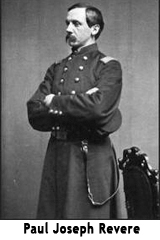|
News in Brief...
New Bloedner Monument dedicated at Cave Hill
Dedication of a replacement monument related to the Battle of Rowlett’s Station in Hart County was conducted in December at Louisville’s Cave Hill Cemetery.
The Bloedner Monument replacement honors the 32nd Indiana Infantry’s role at Rowlett’s Station on Dec. 17, 1861.
The original 32nd Indiana monument was carved in 1862 and moved to Cave Hill National Cemetery in 1867. It’s the oldest known Civil War monument.
Due to its deteriorating condition, the original was removed for conservation and now is on display at Louisville’s Frazier History Museum. The replacement monument honors the original as carved by Union Pvt. August Bloedner to remember the deeds and sacrifices of the German-born soldiers of the 32nd Indiana.
The Battle of Rowlett’s Station was a one-hour skirmish near Munfordville during which the 32nd Indiana, a regiment of German-Americans, warded off a Confederate attack.
Pvt. Bloedner used a natural outcrop of limestone to fashion the monument to honor 13 of his fellow soldiers killed in the battle. The stone was placed on the graves at Munfordville before the infantry departed.
In 1867, the remains of 11 of the soldiers and their monument were moved to the northwest corner of Cave Hill National Cemetery.
Motts named CEO for national Civil War museum
 Civil War authority Wayne Motts has been named chief executive officer for the National Civil War Museum in Harrisburg, Pa. Civil War authority Wayne Motts has been named chief executive officer for the National Civil War Museum in Harrisburg, Pa.
A licensed battlefield guide at Gettysburg National Military Park, Motts was selected from a field of more than 100 candidates. He replaces former Museum CEO Dave Patterson who retired in November.
Motts was executive director of the Adams County (Pa.) Historical Society in Gettysburg for the past eight years. He’s the author of several Civil War books, including Trust in God and Fear Nothing, a biography of Confederate Gen. Lewis A. Armistead, who was killed during the Battle of Gettysburg.
An Ohio native, Motts has lived and worked in the Gettysburg area for nearly 25 years. He holds an undergraduate degree in military history from The Ohio State University and a master’s degree in American history from Shippensburg University of Pennsylvania. He and his wife, Tina, have one grown child.
Civil War Trust earns third four-star ranking
For the third consecutive year, the Civil War Trust has earned a coveted four-star ranking from Charity Navigator, America’s leading charity evaluator.
Only nine percent of charities assessed by the group earn this consistent level of recognition for sound fiscal management and commitment to accountability and transparency.
After evaluating recent financial and other documents, the watchdog group gave the Trust an overall rating of 64.31 on a 70-point scale. Charity Navigator’s recognition is based on the Trust’s successful year in Civil War preservation.
In 2011, the Trust permanently protected 2,042 acres of hallowed ground at 25 battlefields in 12 states.
Currently, efforts are underway to permanently preserve hallowed ground at Mill Springs and Perryville, Ky.; Bentonville, N.C.; Shiloh, Tenn.; and Cedar Creek, Fredericksburg and Gaines’ Mill, Va.
Old Crow was Grant’s drink of choice
Kentucky’s Old Crow bourbon was the drink of choice for Union Gen. U.S. Grant. The General, who later was the 18th president of the United States, was described to President Abraham Lincoln by his critics as being “a drunk.”
Lincoln supposedly replied, “If I can find where Gen. Grant procures his whiskey, I’ll send every general in the field a barrel of it.”
James Crow, a Scottish immigrant, began distilling what would become Old Crow in Frankfort in the 1830s. Old Crow’s logo, a crow perched atop grains of barley, is rumored to stem as a symbol bridging the North and South during the Civil War.
Another prominent personality who enjoyed Old Crow was Kentucky Sen. Henry Clay.
See you later, Alligator? Maybe after while, crocodile
In contrast to the Hunley, the Confederate submarine featured in this issue, the Alligator was a paddle-powered sub manufactured by the Union. It was never used in service due to some early testing problems.
After some speed-boosting revisions, the vessel was sent to Port Royal, S.C., for the intended purpose of aiding in the invasion of Charleston. The Alligator never made it, however, as it had to be cut loose by the U.S.S. Sumter after bad weather struck off the coast of North Carolina on April 2, 1863.
As the Alligator saw no combat, it could not be officially called the U.S.S. Alligator. Divers and historians are still looking for the ill-fated vessel.
Paul Revere also made it to the Civil War
 Paul Revere is famous for his mythical ride during the Revolutionary War, but not so well known for his part in the Civil War. Paul Revere is famous for his mythical ride during the Revolutionary War, but not so well known for his part in the Civil War.
That’s because it was his grandson – Paul Joseph Revere – who showed up at Gettysburg. P.J. Revere, along with his brother, Edward, was a member of the 20th Massachusetts Infantry.
Both of the Reveres were captured at the Battle of Ball’s Bluff (Va.) in October 1861. After being released, they rejoined the war.
Paul was promoted to lieutenant colonel in September 1862 shortly before being wounded in the 1862 Battle of Antietam (Sharpsburg). His brother, however, was among the 2,000 soldiers killed in the Maryland battle.
The next year, Paul was promoted to full colonel and led the 20th at Chancellorsville and at Gettysburg until he was mortally wounded by a shell fragment that pierced his lung. He died the next day. Col. Revere was posthumously promoted to brigadier general and is buried at Cambridge, Mass.
Hunn portrays Miller at Cincinnati library
Camp Nelson re-enactor James Hunn was featured in February at Cincinnati’s Forest Park Branch Library. Hunn did a first-person portrayal of Joseph Miller, a soldier in the 124th U.S. Colored Troops.
|







